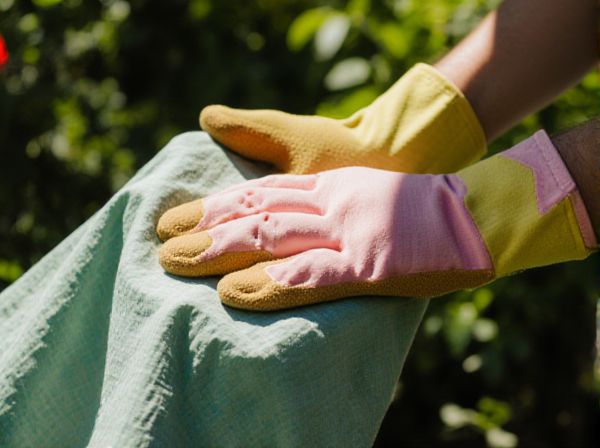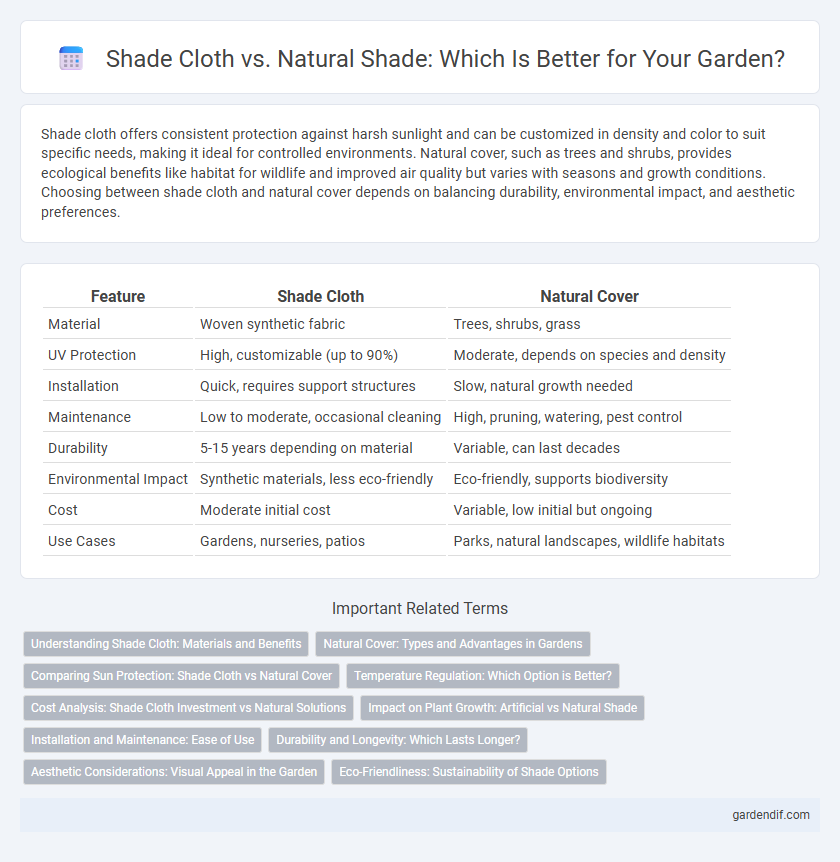
Shade cloth vs natural cover Illustration
Shade cloth offers consistent protection against harsh sunlight and can be customized in density and color to suit specific needs, making it ideal for controlled environments. Natural cover, such as trees and shrubs, provides ecological benefits like habitat for wildlife and improved air quality but varies with seasons and growth conditions. Choosing between shade cloth and natural cover depends on balancing durability, environmental impact, and aesthetic preferences.
Table of Comparison
| Feature | Shade Cloth | Natural Cover |
|---|---|---|
| Material | Woven synthetic fabric | Trees, shrubs, grass |
| UV Protection | High, customizable (up to 90%) | Moderate, depends on species and density |
| Installation | Quick, requires support structures | Slow, natural growth needed |
| Maintenance | Low to moderate, occasional cleaning | High, pruning, watering, pest control |
| Durability | 5-15 years depending on material | Variable, can last decades |
| Environmental Impact | Synthetic materials, less eco-friendly | Eco-friendly, supports biodiversity |
| Cost | Moderate initial cost | Variable, low initial but ongoing |
| Use Cases | Gardens, nurseries, patios | Parks, natural landscapes, wildlife habitats |
Understanding Shade Cloth: Materials and Benefits
Shade cloth, typically made from woven polyethylene or UV-stabilized fabrics, offers controlled light filtration and durability compared to natural cover like trees or shrubs. These synthetic materials provide customizable shade percentages, enhancing plant protection from excessive sunlight and heat stress while allowing airflow to prevent overheating. Benefits include longevity, pest resistance, and ease of installation, making shade cloth an efficient solution for agriculture, gardening, and outdoor spaces.
Natural Cover: Types and Advantages in Gardens
Natural cover in gardens includes trees, shrubs, and groundcovers that provide organic shade, promoting biodiversity and improving soil health through leaf litter decomposition. Unlike shade cloth, natural cover supports local ecosystems, enhances air quality, and offers aesthetic and habitat benefits while regulating microclimates. Selecting native plant species optimizes shade effectiveness and resilience, creating a sustainable and visually appealing garden environment.
Comparing Sun Protection: Shade Cloth vs Natural Cover
Shade cloth offers consistent UV protection with customizable density options, ensuring tailored sun blockage for plants and outdoor spaces, unlike natural cover which varies seasonally and depends on plant type. Natural cover provides ecological benefits such as habitat and soil improvement but may be less reliable for continuous shade and temperature control. Choosing shade cloth allows precise management of sunlight exposure, critical for sensitive crops or space with fluctuating sun intensity.
Temperature Regulation: Which Option is Better?
Shade cloth offers superior temperature regulation by providing consistent and adjustable shading, effectively reducing heat buildup and protecting plants from extreme sunlight. Natural cover, such as tree canopies, offers additional benefits like moisture retention and soil stabilization but may result in uneven shading and less precise temperature control. For optimal temperature regulation in horticulture or outdoor spaces, shade cloth is often the better option due to its customizable density and UV filtration capabilities.
Cost Analysis: Shade Cloth Investment vs Natural Solutions
Shade cloth offers a predictable initial investment with costs ranging from $0.50 to $2.00 per square foot, providing immediate and adjustable sun protection for crops or outdoor spaces. Natural cover, such as trees or shrubs, involves lower upfront expenses but requires years to establish, along with ongoing maintenance costs like watering and pruning. When evaluating cost efficiency, shade cloth delivers faster results and lower long-term labor costs, while natural cover offers sustainability benefits but demands patience and consistent upkeep.
Impact on Plant Growth: Artificial vs Natural Shade
Shade cloth regulates light intensity and temperature more consistently than natural cover, promoting uniform plant growth in controlled environments. Natural shade varies with seasonal changes and leaf density, influencing photosynthesis and moisture retention differently across plant species. Artificial shade provides predictable conditions, while natural cover enhances biodiversity and soil quality through organic matter.
Installation and Maintenance: Ease of Use
Shade cloth offers straightforward installation with lightweight materials that can be easily mounted on frames, poles, or existing structures, requiring minimal tools and skills. Natural cover, such as trees or shrubs, demands longer growth periods and more complex care routines including pruning, watering, and pest management. The low maintenance and flexibility of shade cloth make it a practical choice for quick deployment and consistent shade control compared to the variable and time-intensive upkeep of living plants.
Durability and Longevity: Which Lasts Longer?
Shade cloth typically offers greater durability and longevity compared to natural cover due to its resistance to weather elements such as UV rays, wind, and rain. Unlike natural foliage that can wilt, decay, or suffer seasonal changes, high-quality shade cloth can maintain its effectiveness for 5 to 15 years depending on material composition like polyethylene or polypropylene. This makes shade cloth a reliable choice for long-term shading solutions in both agricultural and commercial settings.
Aesthetic Considerations: Visual Appeal in the Garden
Shade cloth offers a uniform, customizable appearance with various colors and densities, enhancing garden design by creating structured shade patterns. Natural cover, such as trees and shrubs, provides dynamic visual interest through seasonal changes, diverse textures, and organic shapes that evolve over time. Combining shade cloth with natural cover can balance controlled aesthetics and the natural beauty of living plants.
Eco-Friendliness: Sustainability of Shade Options
Shade cloth offers a sustainable solution by reducing water usage and minimizing soil erosion compared to natural cover like trees or grass, which require ongoing maintenance and resources. While natural cover supports biodiversity and carbon sequestration, shade cloth has a lower environmental footprint during installation and can be recycled or reused. The overall eco-friendliness depends on the specific application, but shade cloth provides a durable, resource-efficient alternative for controlled shading needs.
Shade cloth vs natural cover Infographic

 gardendif.com
gardendif.com